Revolutionizing Healthcare: An In-depth Look at IoT Applications
VerifiedAdded on 2023/06/10
|23
|6687
|388
Report
AI Summary
This report examines the increasing use of the Internet of Things (IoT) in healthcare, focusing on its impact on personal healthcare, payment applications, and the healthcare industry. It highlights the potential of IoT to enhance care through remote monitoring and tele-monitoring, addressing the growing demand for efficient and high-quality healthcare services. The report discusses the benefits of IoT in healthcare, including continuous reporting and monitoring, affordability and end-to-end connectivity, data collection and investigation, alerts and tracking, and remote medical support. It also explores the challenges and solutions associated with IoT implementation, such as integration issues, data accuracy, and security concerns. Furthermore, the study reviews state-of-the-art network architectures, platforms, applications, and industrial trends in healthcare solutions, while also analyzing different IoT security and privacy features. The report concludes by addressing the role of big data, wearable technology, and ambient intelligence in the healthcare context, as well as examining relevant IoT and e-Health policies and regulations worldwide.
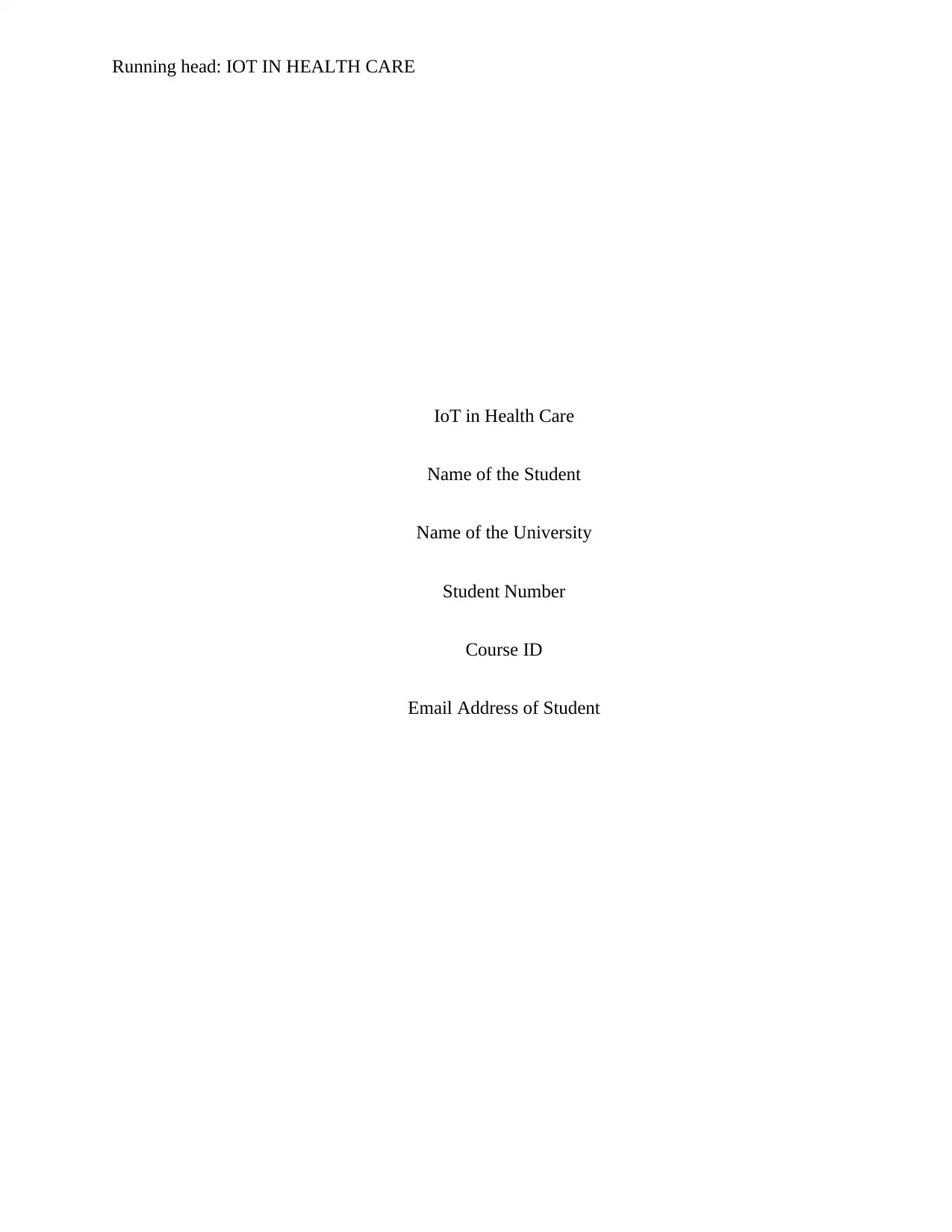
Running head: IOT IN HEALTH CARE
IoT in Health Care
Name of the Student
Name of the University
Student Number
Course ID
Email Address of Student
IoT in Health Care
Name of the Student
Name of the University
Student Number
Course ID
Email Address of Student
Paraphrase This Document
Need a fresh take? Get an instant paraphrase of this document with our AI Paraphraser
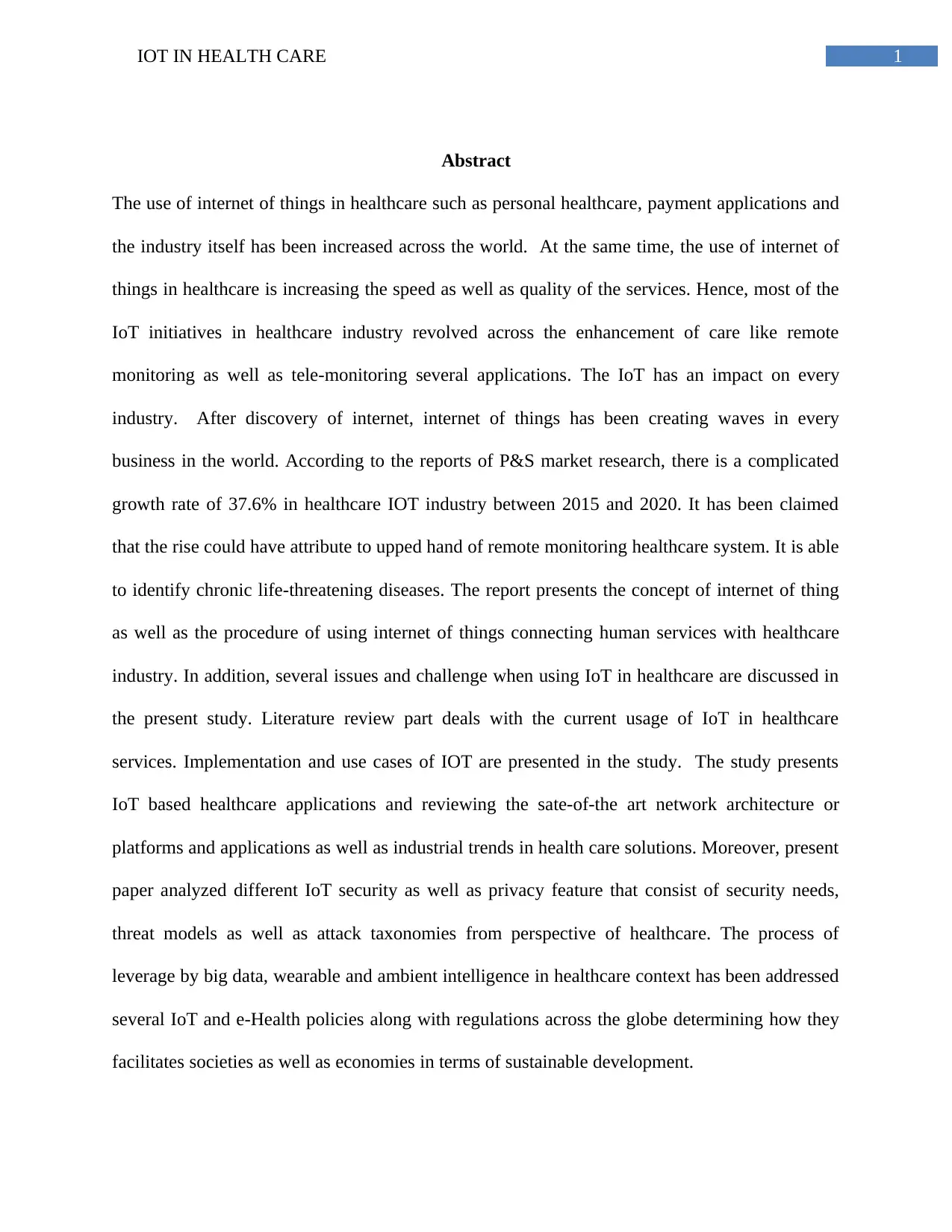
1IOT IN HEALTH CARE
Abstract
The use of internet of things in healthcare such as personal healthcare, payment applications and
the industry itself has been increased across the world. At the same time, the use of internet of
things in healthcare is increasing the speed as well as quality of the services. Hence, most of the
IoT initiatives in healthcare industry revolved across the enhancement of care like remote
monitoring as well as tele-monitoring several applications. The IoT has an impact on every
industry. After discovery of internet, internet of things has been creating waves in every
business in the world. According to the reports of P&S market research, there is a complicated
growth rate of 37.6% in healthcare IOT industry between 2015 and 2020. It has been claimed
that the rise could have attribute to upped hand of remote monitoring healthcare system. It is able
to identify chronic life-threatening diseases. The report presents the concept of internet of thing
as well as the procedure of using internet of things connecting human services with healthcare
industry. In addition, several issues and challenge when using IoT in healthcare are discussed in
the present study. Literature review part deals with the current usage of IoT in healthcare
services. Implementation and use cases of IOT are presented in the study. The study presents
IoT based healthcare applications and reviewing the sate-of-the art network architecture or
platforms and applications as well as industrial trends in health care solutions. Moreover, present
paper analyzed different IoT security as well as privacy feature that consist of security needs,
threat models as well as attack taxonomies from perspective of healthcare. The process of
leverage by big data, wearable and ambient intelligence in healthcare context has been addressed
several IoT and e-Health policies along with regulations across the globe determining how they
facilitates societies as well as economies in terms of sustainable development.
Abstract
The use of internet of things in healthcare such as personal healthcare, payment applications and
the industry itself has been increased across the world. At the same time, the use of internet of
things in healthcare is increasing the speed as well as quality of the services. Hence, most of the
IoT initiatives in healthcare industry revolved across the enhancement of care like remote
monitoring as well as tele-monitoring several applications. The IoT has an impact on every
industry. After discovery of internet, internet of things has been creating waves in every
business in the world. According to the reports of P&S market research, there is a complicated
growth rate of 37.6% in healthcare IOT industry between 2015 and 2020. It has been claimed
that the rise could have attribute to upped hand of remote monitoring healthcare system. It is able
to identify chronic life-threatening diseases. The report presents the concept of internet of thing
as well as the procedure of using internet of things connecting human services with healthcare
industry. In addition, several issues and challenge when using IoT in healthcare are discussed in
the present study. Literature review part deals with the current usage of IoT in healthcare
services. Implementation and use cases of IOT are presented in the study. The study presents
IoT based healthcare applications and reviewing the sate-of-the art network architecture or
platforms and applications as well as industrial trends in health care solutions. Moreover, present
paper analyzed different IoT security as well as privacy feature that consist of security needs,
threat models as well as attack taxonomies from perspective of healthcare. The process of
leverage by big data, wearable and ambient intelligence in healthcare context has been addressed
several IoT and e-Health policies along with regulations across the globe determining how they
facilitates societies as well as economies in terms of sustainable development.
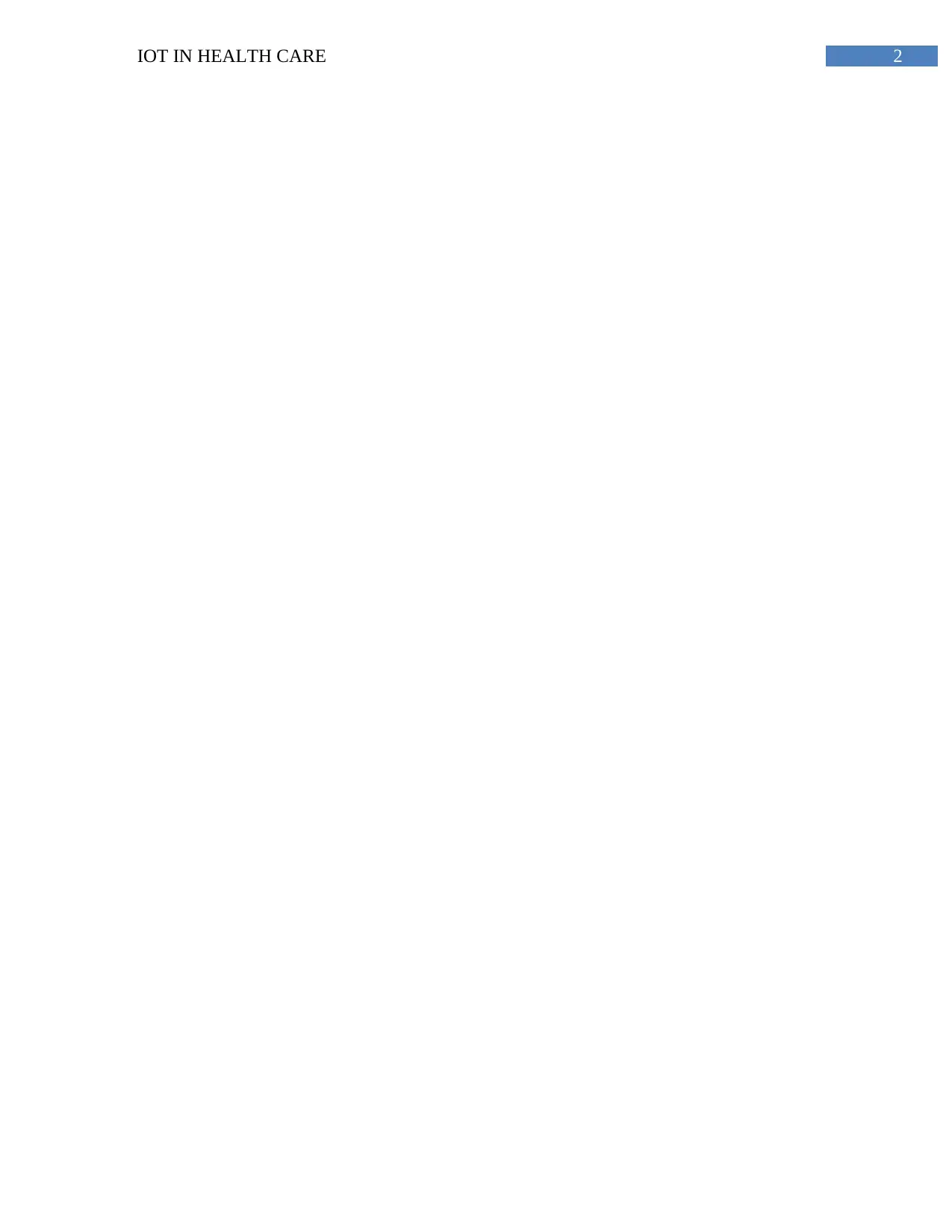
2IOT IN HEALTH CARE
⊘ This is a preview!⊘
Do you want full access?
Subscribe today to unlock all pages.

Trusted by 1+ million students worldwide
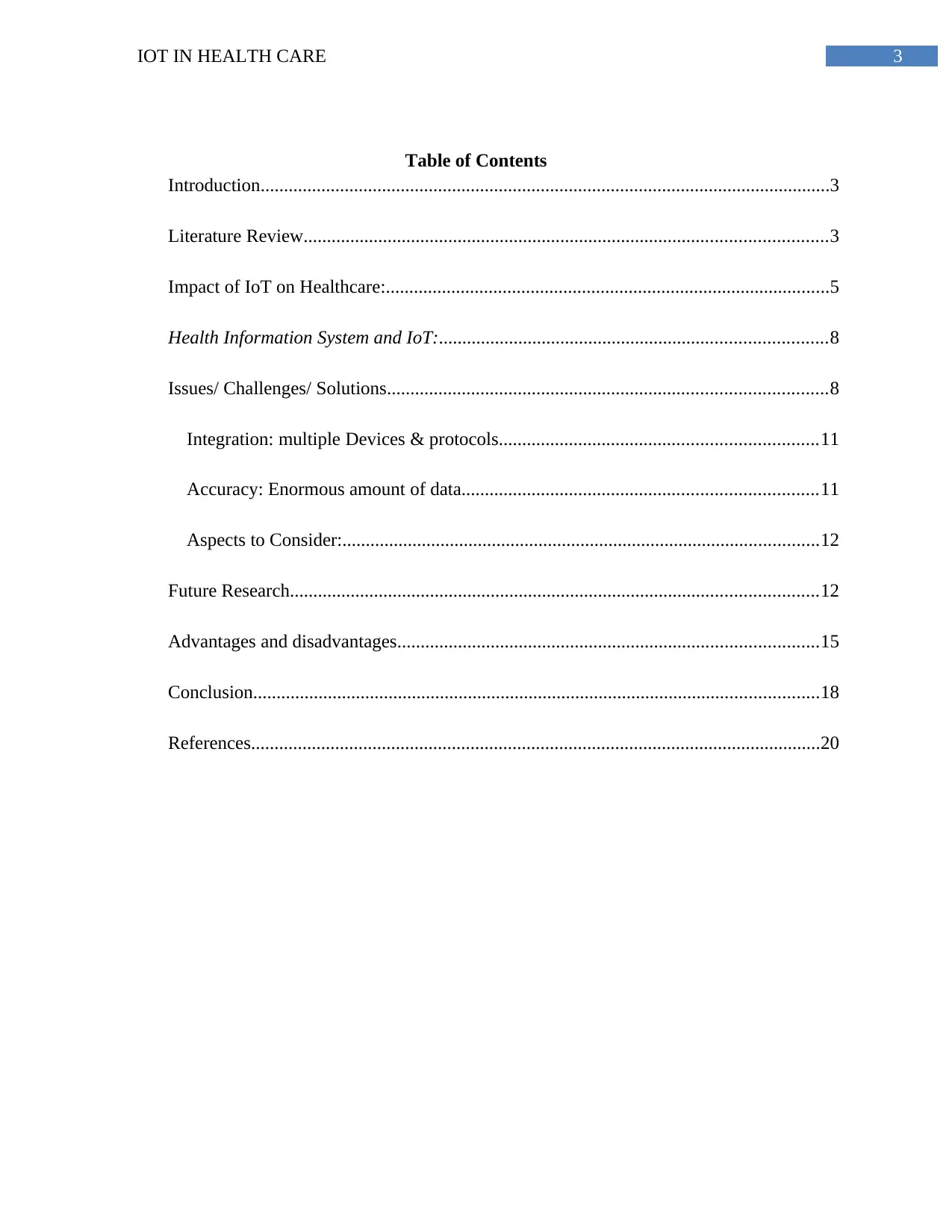
3IOT IN HEALTH CARE
Table of Contents
Introduction..........................................................................................................................3
Literature Review................................................................................................................3
Impact of IoT on Healthcare:...............................................................................................5
Health Information System and IoT:...................................................................................8
Issues/ Challenges/ Solutions..............................................................................................8
Integration: multiple Devices & protocols....................................................................11
Accuracy: Enormous amount of data............................................................................11
Aspects to Consider:......................................................................................................12
Future Research.................................................................................................................12
Advantages and disadvantages..........................................................................................15
Conclusion.........................................................................................................................18
References..........................................................................................................................20
Table of Contents
Introduction..........................................................................................................................3
Literature Review................................................................................................................3
Impact of IoT on Healthcare:...............................................................................................5
Health Information System and IoT:...................................................................................8
Issues/ Challenges/ Solutions..............................................................................................8
Integration: multiple Devices & protocols....................................................................11
Accuracy: Enormous amount of data............................................................................11
Aspects to Consider:......................................................................................................12
Future Research.................................................................................................................12
Advantages and disadvantages..........................................................................................15
Conclusion.........................................................................................................................18
References..........................................................................................................................20
Paraphrase This Document
Need a fresh take? Get an instant paraphrase of this document with our AI Paraphraser
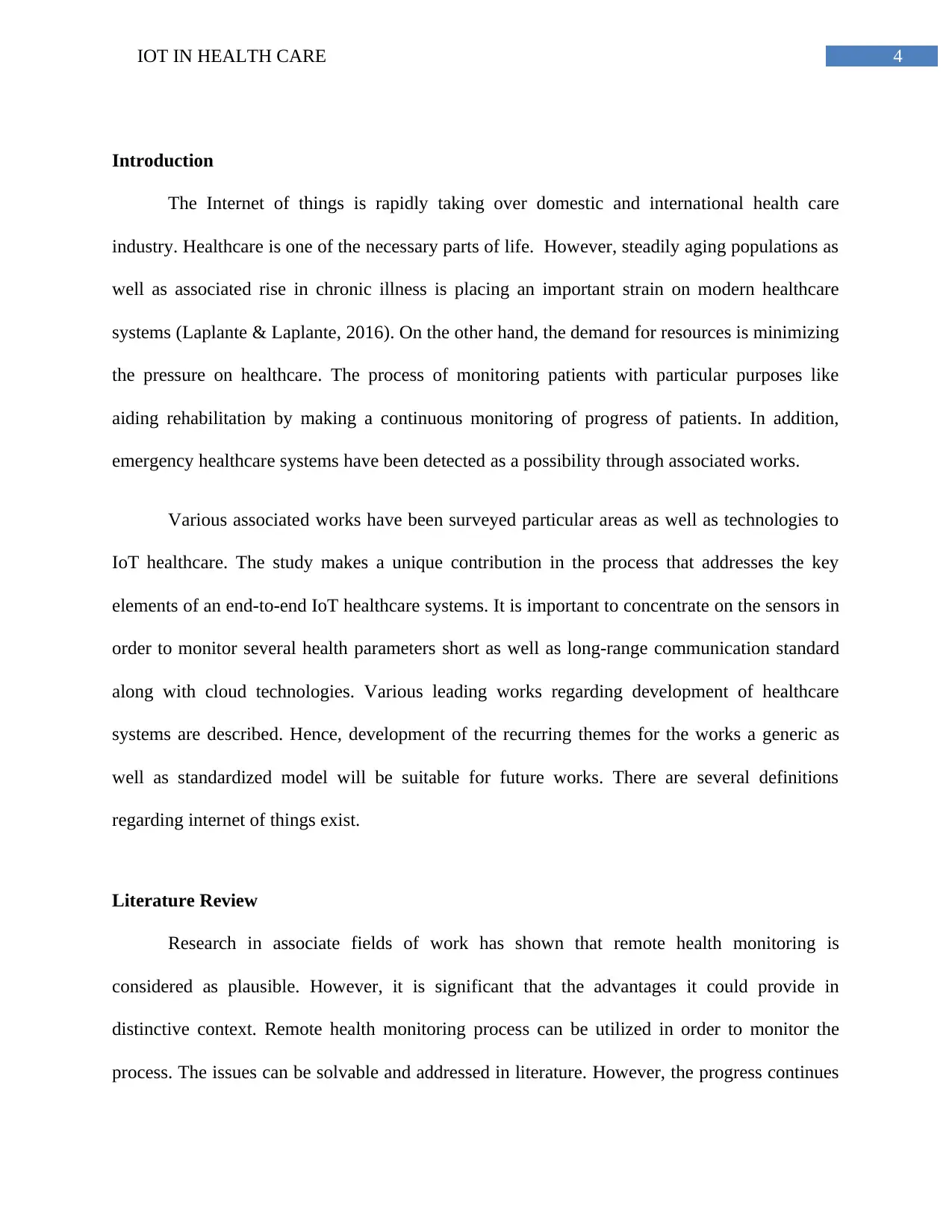
4IOT IN HEALTH CARE
Introduction
The Internet of things is rapidly taking over domestic and international health care
industry. Healthcare is one of the necessary parts of life. However, steadily aging populations as
well as associated rise in chronic illness is placing an important strain on modern healthcare
systems (Laplante & Laplante, 2016). On the other hand, the demand for resources is minimizing
the pressure on healthcare. The process of monitoring patients with particular purposes like
aiding rehabilitation by making a continuous monitoring of progress of patients. In addition,
emergency healthcare systems have been detected as a possibility through associated works.
Various associated works have been surveyed particular areas as well as technologies to
IoT healthcare. The study makes a unique contribution in the process that addresses the key
elements of an end-to-end IoT healthcare systems. It is important to concentrate on the sensors in
order to monitor several health parameters short as well as long-range communication standard
along with cloud technologies. Various leading works regarding development of healthcare
systems are described. Hence, development of the recurring themes for the works a generic as
well as standardized model will be suitable for future works. There are several definitions
regarding internet of things exist.
Literature Review
Research in associate fields of work has shown that remote health monitoring is
considered as plausible. However, it is significant that the advantages it could provide in
distinctive context. Remote health monitoring process can be utilized in order to monitor the
process. The issues can be solvable and addressed in literature. However, the progress continues
Introduction
The Internet of things is rapidly taking over domestic and international health care
industry. Healthcare is one of the necessary parts of life. However, steadily aging populations as
well as associated rise in chronic illness is placing an important strain on modern healthcare
systems (Laplante & Laplante, 2016). On the other hand, the demand for resources is minimizing
the pressure on healthcare. The process of monitoring patients with particular purposes like
aiding rehabilitation by making a continuous monitoring of progress of patients. In addition,
emergency healthcare systems have been detected as a possibility through associated works.
Various associated works have been surveyed particular areas as well as technologies to
IoT healthcare. The study makes a unique contribution in the process that addresses the key
elements of an end-to-end IoT healthcare systems. It is important to concentrate on the sensors in
order to monitor several health parameters short as well as long-range communication standard
along with cloud technologies. Various leading works regarding development of healthcare
systems are described. Hence, development of the recurring themes for the works a generic as
well as standardized model will be suitable for future works. There are several definitions
regarding internet of things exist.
Literature Review
Research in associate fields of work has shown that remote health monitoring is
considered as plausible. However, it is significant that the advantages it could provide in
distinctive context. Remote health monitoring process can be utilized in order to monitor the
process. The issues can be solvable and addressed in literature. However, the progress continues
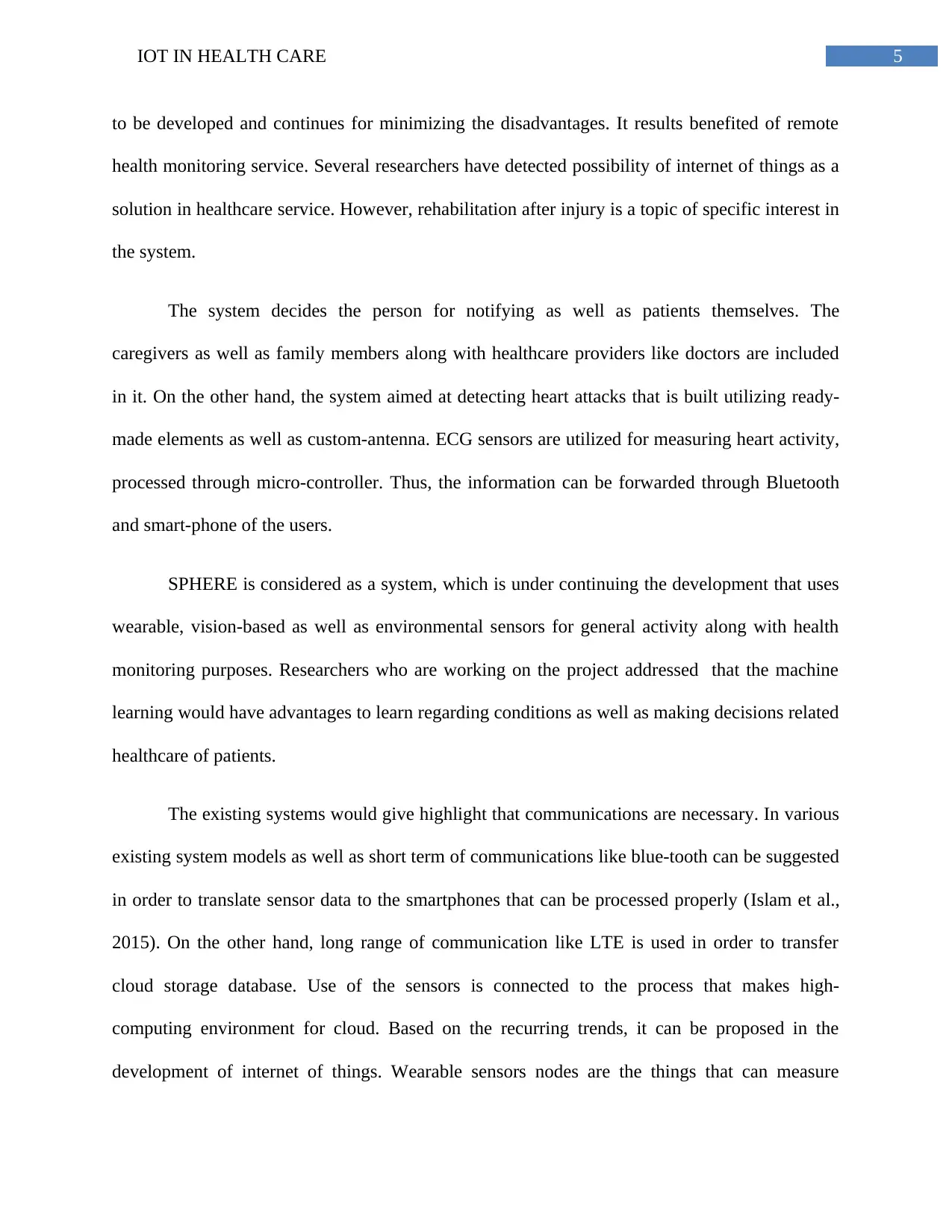
5IOT IN HEALTH CARE
to be developed and continues for minimizing the disadvantages. It results benefited of remote
health monitoring service. Several researchers have detected possibility of internet of things as a
solution in healthcare service. However, rehabilitation after injury is a topic of specific interest in
the system.
The system decides the person for notifying as well as patients themselves. The
caregivers as well as family members along with healthcare providers like doctors are included
in it. On the other hand, the system aimed at detecting heart attacks that is built utilizing ready-
made elements as well as custom-antenna. ECG sensors are utilized for measuring heart activity,
processed through micro-controller. Thus, the information can be forwarded through Bluetooth
and smart-phone of the users.
SPHERE is considered as a system, which is under continuing the development that uses
wearable, vision-based as well as environmental sensors for general activity along with health
monitoring purposes. Researchers who are working on the project addressed that the machine
learning would have advantages to learn regarding conditions as well as making decisions related
healthcare of patients.
The existing systems would give highlight that communications are necessary. In various
existing system models as well as short term of communications like blue-tooth can be suggested
in order to translate sensor data to the smartphones that can be processed properly (Islam et al.,
2015). On the other hand, long range of communication like LTE is used in order to transfer
cloud storage database. Use of the sensors is connected to the process that makes high-
computing environment for cloud. Based on the recurring trends, it can be proposed in the
development of internet of things. Wearable sensors nodes are the things that can measure
to be developed and continues for minimizing the disadvantages. It results benefited of remote
health monitoring service. Several researchers have detected possibility of internet of things as a
solution in healthcare service. However, rehabilitation after injury is a topic of specific interest in
the system.
The system decides the person for notifying as well as patients themselves. The
caregivers as well as family members along with healthcare providers like doctors are included
in it. On the other hand, the system aimed at detecting heart attacks that is built utilizing ready-
made elements as well as custom-antenna. ECG sensors are utilized for measuring heart activity,
processed through micro-controller. Thus, the information can be forwarded through Bluetooth
and smart-phone of the users.
SPHERE is considered as a system, which is under continuing the development that uses
wearable, vision-based as well as environmental sensors for general activity along with health
monitoring purposes. Researchers who are working on the project addressed that the machine
learning would have advantages to learn regarding conditions as well as making decisions related
healthcare of patients.
The existing systems would give highlight that communications are necessary. In various
existing system models as well as short term of communications like blue-tooth can be suggested
in order to translate sensor data to the smartphones that can be processed properly (Islam et al.,
2015). On the other hand, long range of communication like LTE is used in order to transfer
cloud storage database. Use of the sensors is connected to the process that makes high-
computing environment for cloud. Based on the recurring trends, it can be proposed in the
development of internet of things. Wearable sensors nodes are the things that can measure
⊘ This is a preview!⊘
Do you want full access?
Subscribe today to unlock all pages.

Trusted by 1+ million students worldwide
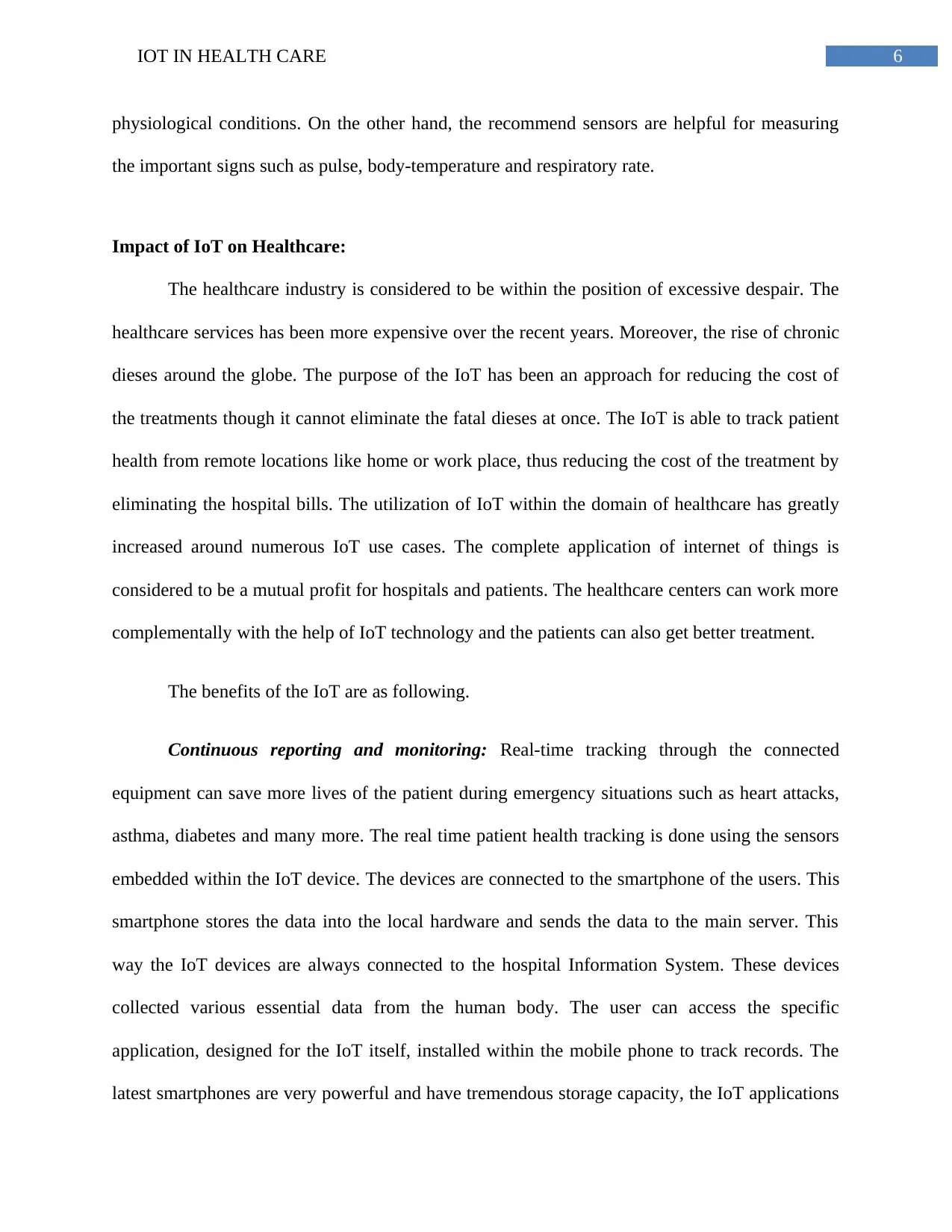
6IOT IN HEALTH CARE
physiological conditions. On the other hand, the recommend sensors are helpful for measuring
the important signs such as pulse, body-temperature and respiratory rate.
Impact of IoT on Healthcare:
The healthcare industry is considered to be within the position of excessive despair. The
healthcare services has been more expensive over the recent years. Moreover, the rise of chronic
dieses around the globe. The purpose of the IoT has been an approach for reducing the cost of
the treatments though it cannot eliminate the fatal dieses at once. The IoT is able to track patient
health from remote locations like home or work place, thus reducing the cost of the treatment by
eliminating the hospital bills. The utilization of IoT within the domain of healthcare has greatly
increased around numerous IoT use cases. The complete application of internet of things is
considered to be a mutual profit for hospitals and patients. The healthcare centers can work more
complementally with the help of IoT technology and the patients can also get better treatment.
The benefits of the IoT are as following.
Continuous reporting and monitoring: Real-time tracking through the connected
equipment can save more lives of the patient during emergency situations such as heart attacks,
asthma, diabetes and many more. The real time patient health tracking is done using the sensors
embedded within the IoT device. The devices are connected to the smartphone of the users. This
smartphone stores the data into the local hardware and sends the data to the main server. This
way the IoT devices are always connected to the hospital Information System. These devices
collected various essential data from the human body. The user can access the specific
application, designed for the IoT itself, installed within the mobile phone to track records. The
latest smartphones are very powerful and have tremendous storage capacity, the IoT applications
physiological conditions. On the other hand, the recommend sensors are helpful for measuring
the important signs such as pulse, body-temperature and respiratory rate.
Impact of IoT on Healthcare:
The healthcare industry is considered to be within the position of excessive despair. The
healthcare services has been more expensive over the recent years. Moreover, the rise of chronic
dieses around the globe. The purpose of the IoT has been an approach for reducing the cost of
the treatments though it cannot eliminate the fatal dieses at once. The IoT is able to track patient
health from remote locations like home or work place, thus reducing the cost of the treatment by
eliminating the hospital bills. The utilization of IoT within the domain of healthcare has greatly
increased around numerous IoT use cases. The complete application of internet of things is
considered to be a mutual profit for hospitals and patients. The healthcare centers can work more
complementally with the help of IoT technology and the patients can also get better treatment.
The benefits of the IoT are as following.
Continuous reporting and monitoring: Real-time tracking through the connected
equipment can save more lives of the patient during emergency situations such as heart attacks,
asthma, diabetes and many more. The real time patient health tracking is done using the sensors
embedded within the IoT device. The devices are connected to the smartphone of the users. This
smartphone stores the data into the local hardware and sends the data to the main server. This
way the IoT devices are always connected to the hospital Information System. These devices
collected various essential data from the human body. The user can access the specific
application, designed for the IoT itself, installed within the mobile phone to track records. The
latest smartphones are very powerful and have tremendous storage capacity, the IoT applications
Paraphrase This Document
Need a fresh take? Get an instant paraphrase of this document with our AI Paraphraser
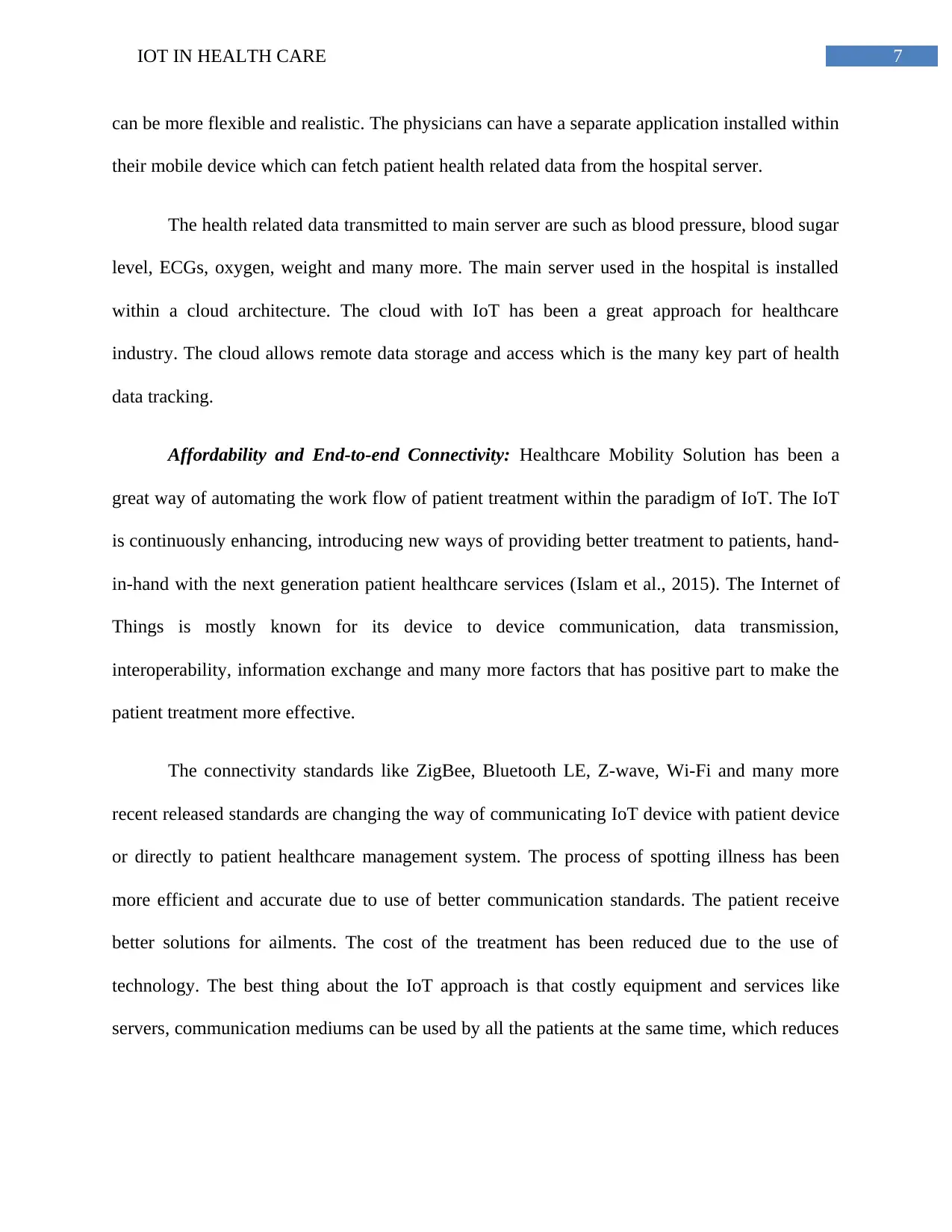
7IOT IN HEALTH CARE
can be more flexible and realistic. The physicians can have a separate application installed within
their mobile device which can fetch patient health related data from the hospital server.
The health related data transmitted to main server are such as blood pressure, blood sugar
level, ECGs, oxygen, weight and many more. The main server used in the hospital is installed
within a cloud architecture. The cloud with IoT has been a great approach for healthcare
industry. The cloud allows remote data storage and access which is the many key part of health
data tracking.
Affordability and End-to-end Connectivity: Healthcare Mobility Solution has been a
great way of automating the work flow of patient treatment within the paradigm of IoT. The IoT
is continuously enhancing, introducing new ways of providing better treatment to patients, hand-
in-hand with the next generation patient healthcare services (Islam et al., 2015). The Internet of
Things is mostly known for its device to device communication, data transmission,
interoperability, information exchange and many more factors that has positive part to make the
patient treatment more effective.
The connectivity standards like ZigBee, Bluetooth LE, Z-wave, Wi-Fi and many more
recent released standards are changing the way of communicating IoT device with patient device
or directly to patient healthcare management system. The process of spotting illness has been
more efficient and accurate due to use of better communication standards. The patient receive
better solutions for ailments. The cost of the treatment has been reduced due to the use of
technology. The best thing about the IoT approach is that costly equipment and services like
servers, communication mediums can be used by all the patients at the same time, which reduces
can be more flexible and realistic. The physicians can have a separate application installed within
their mobile device which can fetch patient health related data from the hospital server.
The health related data transmitted to main server are such as blood pressure, blood sugar
level, ECGs, oxygen, weight and many more. The main server used in the hospital is installed
within a cloud architecture. The cloud with IoT has been a great approach for healthcare
industry. The cloud allows remote data storage and access which is the many key part of health
data tracking.
Affordability and End-to-end Connectivity: Healthcare Mobility Solution has been a
great way of automating the work flow of patient treatment within the paradigm of IoT. The IoT
is continuously enhancing, introducing new ways of providing better treatment to patients, hand-
in-hand with the next generation patient healthcare services (Islam et al., 2015). The Internet of
Things is mostly known for its device to device communication, data transmission,
interoperability, information exchange and many more factors that has positive part to make the
patient treatment more effective.
The connectivity standards like ZigBee, Bluetooth LE, Z-wave, Wi-Fi and many more
recent released standards are changing the way of communicating IoT device with patient device
or directly to patient healthcare management system. The process of spotting illness has been
more efficient and accurate due to use of better communication standards. The patient receive
better solutions for ailments. The cost of the treatment has been reduced due to the use of
technology. The best thing about the IoT approach is that costly equipment and services like
servers, communication mediums can be used by all the patients at the same time, which reduces
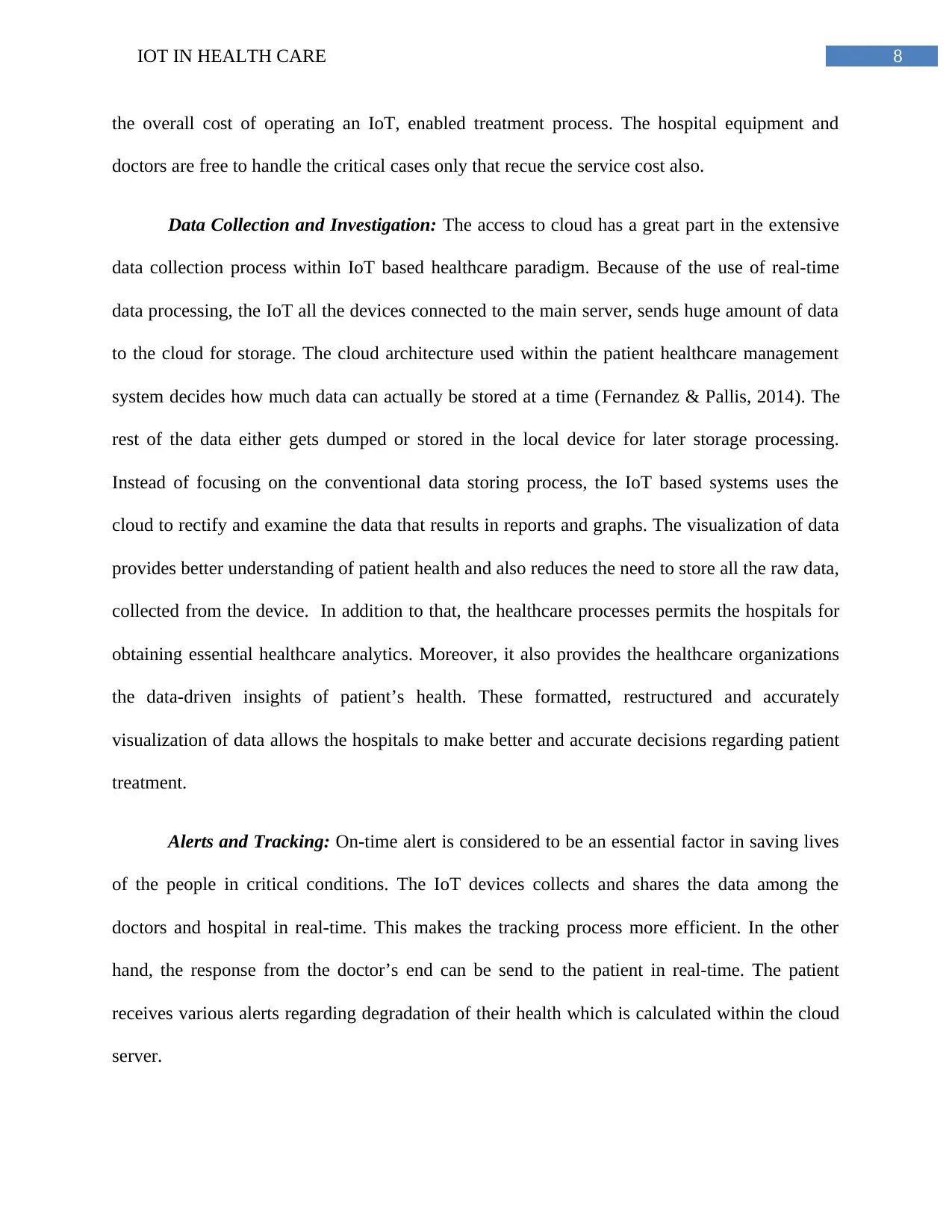
8IOT IN HEALTH CARE
the overall cost of operating an IoT, enabled treatment process. The hospital equipment and
doctors are free to handle the critical cases only that recue the service cost also.
Data Collection and Investigation: The access to cloud has a great part in the extensive
data collection process within IoT based healthcare paradigm. Because of the use of real-time
data processing, the IoT all the devices connected to the main server, sends huge amount of data
to the cloud for storage. The cloud architecture used within the patient healthcare management
system decides how much data can actually be stored at a time (Fernandez & Pallis, 2014). The
rest of the data either gets dumped or stored in the local device for later storage processing.
Instead of focusing on the conventional data storing process, the IoT based systems uses the
cloud to rectify and examine the data that results in reports and graphs. The visualization of data
provides better understanding of patient health and also reduces the need to store all the raw data,
collected from the device. In addition to that, the healthcare processes permits the hospitals for
obtaining essential healthcare analytics. Moreover, it also provides the healthcare organizations
the data-driven insights of patient’s health. These formatted, restructured and accurately
visualization of data allows the hospitals to make better and accurate decisions regarding patient
treatment.
Alerts and Tracking: On-time alert is considered to be an essential factor in saving lives
of the people in critical conditions. The IoT devices collects and shares the data among the
doctors and hospital in real-time. This makes the tracking process more efficient. In the other
hand, the response from the doctor’s end can be send to the patient in real-time. The patient
receives various alerts regarding degradation of their health which is calculated within the cloud
server.
the overall cost of operating an IoT, enabled treatment process. The hospital equipment and
doctors are free to handle the critical cases only that recue the service cost also.
Data Collection and Investigation: The access to cloud has a great part in the extensive
data collection process within IoT based healthcare paradigm. Because of the use of real-time
data processing, the IoT all the devices connected to the main server, sends huge amount of data
to the cloud for storage. The cloud architecture used within the patient healthcare management
system decides how much data can actually be stored at a time (Fernandez & Pallis, 2014). The
rest of the data either gets dumped or stored in the local device for later storage processing.
Instead of focusing on the conventional data storing process, the IoT based systems uses the
cloud to rectify and examine the data that results in reports and graphs. The visualization of data
provides better understanding of patient health and also reduces the need to store all the raw data,
collected from the device. In addition to that, the healthcare processes permits the hospitals for
obtaining essential healthcare analytics. Moreover, it also provides the healthcare organizations
the data-driven insights of patient’s health. These formatted, restructured and accurately
visualization of data allows the hospitals to make better and accurate decisions regarding patient
treatment.
Alerts and Tracking: On-time alert is considered to be an essential factor in saving lives
of the people in critical conditions. The IoT devices collects and shares the data among the
doctors and hospital in real-time. This makes the tracking process more efficient. In the other
hand, the response from the doctor’s end can be send to the patient in real-time. The patient
receives various alerts regarding degradation of their health which is calculated within the cloud
server.
⊘ This is a preview!⊘
Do you want full access?
Subscribe today to unlock all pages.

Trusted by 1+ million students worldwide
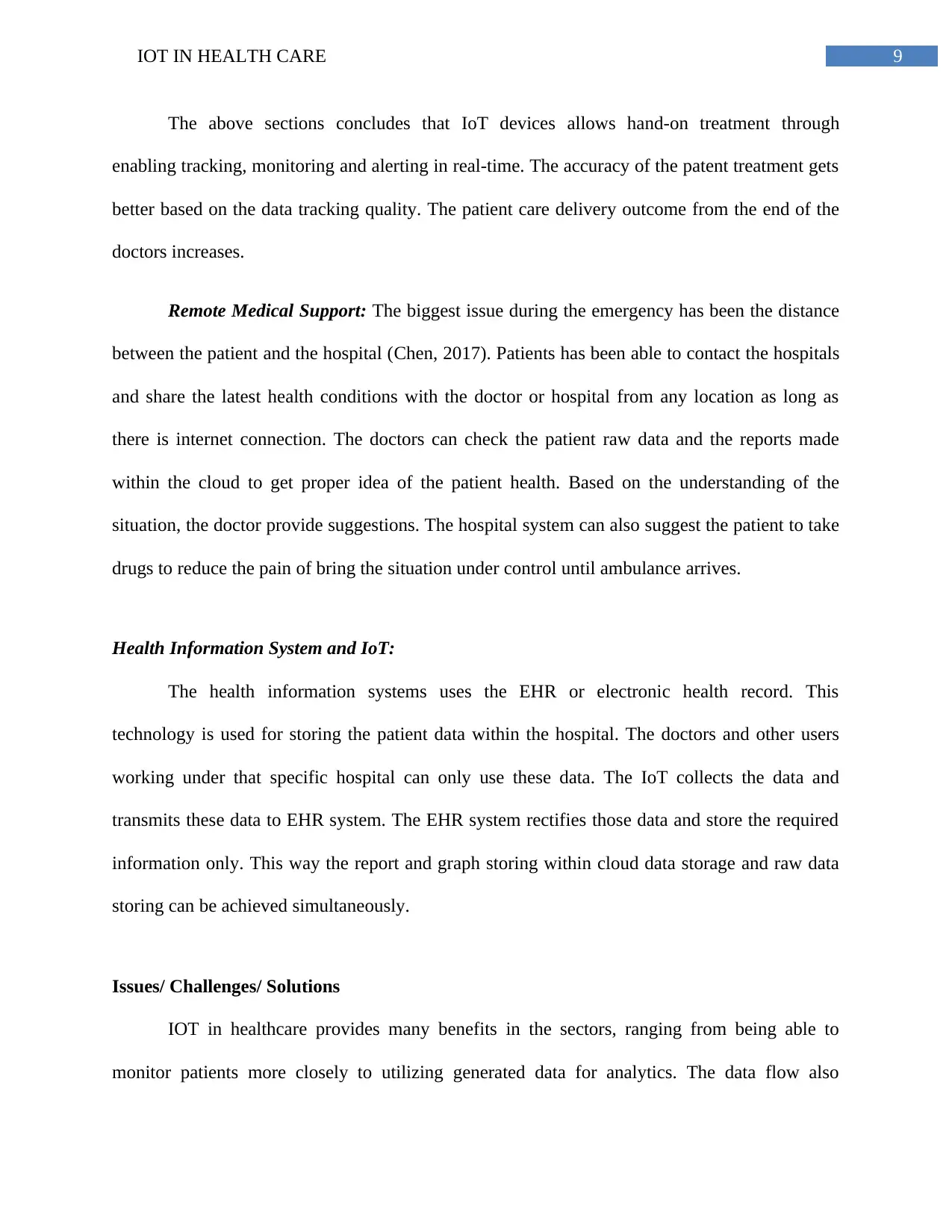
9IOT IN HEALTH CARE
The above sections concludes that IoT devices allows hand-on treatment through
enabling tracking, monitoring and alerting in real-time. The accuracy of the patent treatment gets
better based on the data tracking quality. The patient care delivery outcome from the end of the
doctors increases.
Remote Medical Support: The biggest issue during the emergency has been the distance
between the patient and the hospital (Chen, 2017). Patients has been able to contact the hospitals
and share the latest health conditions with the doctor or hospital from any location as long as
there is internet connection. The doctors can check the patient raw data and the reports made
within the cloud to get proper idea of the patient health. Based on the understanding of the
situation, the doctor provide suggestions. The hospital system can also suggest the patient to take
drugs to reduce the pain of bring the situation under control until ambulance arrives.
Health Information System and IoT:
The health information systems uses the EHR or electronic health record. This
technology is used for storing the patient data within the hospital. The doctors and other users
working under that specific hospital can only use these data. The IoT collects the data and
transmits these data to EHR system. The EHR system rectifies those data and store the required
information only. This way the report and graph storing within cloud data storage and raw data
storing can be achieved simultaneously.
Issues/ Challenges/ Solutions
IOT in healthcare provides many benefits in the sectors, ranging from being able to
monitor patients more closely to utilizing generated data for analytics. The data flow also
The above sections concludes that IoT devices allows hand-on treatment through
enabling tracking, monitoring and alerting in real-time. The accuracy of the patent treatment gets
better based on the data tracking quality. The patient care delivery outcome from the end of the
doctors increases.
Remote Medical Support: The biggest issue during the emergency has been the distance
between the patient and the hospital (Chen, 2017). Patients has been able to contact the hospitals
and share the latest health conditions with the doctor or hospital from any location as long as
there is internet connection. The doctors can check the patient raw data and the reports made
within the cloud to get proper idea of the patient health. Based on the understanding of the
situation, the doctor provide suggestions. The hospital system can also suggest the patient to take
drugs to reduce the pain of bring the situation under control until ambulance arrives.
Health Information System and IoT:
The health information systems uses the EHR or electronic health record. This
technology is used for storing the patient data within the hospital. The doctors and other users
working under that specific hospital can only use these data. The IoT collects the data and
transmits these data to EHR system. The EHR system rectifies those data and store the required
information only. This way the report and graph storing within cloud data storage and raw data
storing can be achieved simultaneously.
Issues/ Challenges/ Solutions
IOT in healthcare provides many benefits in the sectors, ranging from being able to
monitor patients more closely to utilizing generated data for analytics. The data flow also
Paraphrase This Document
Need a fresh take? Get an instant paraphrase of this document with our AI Paraphraser
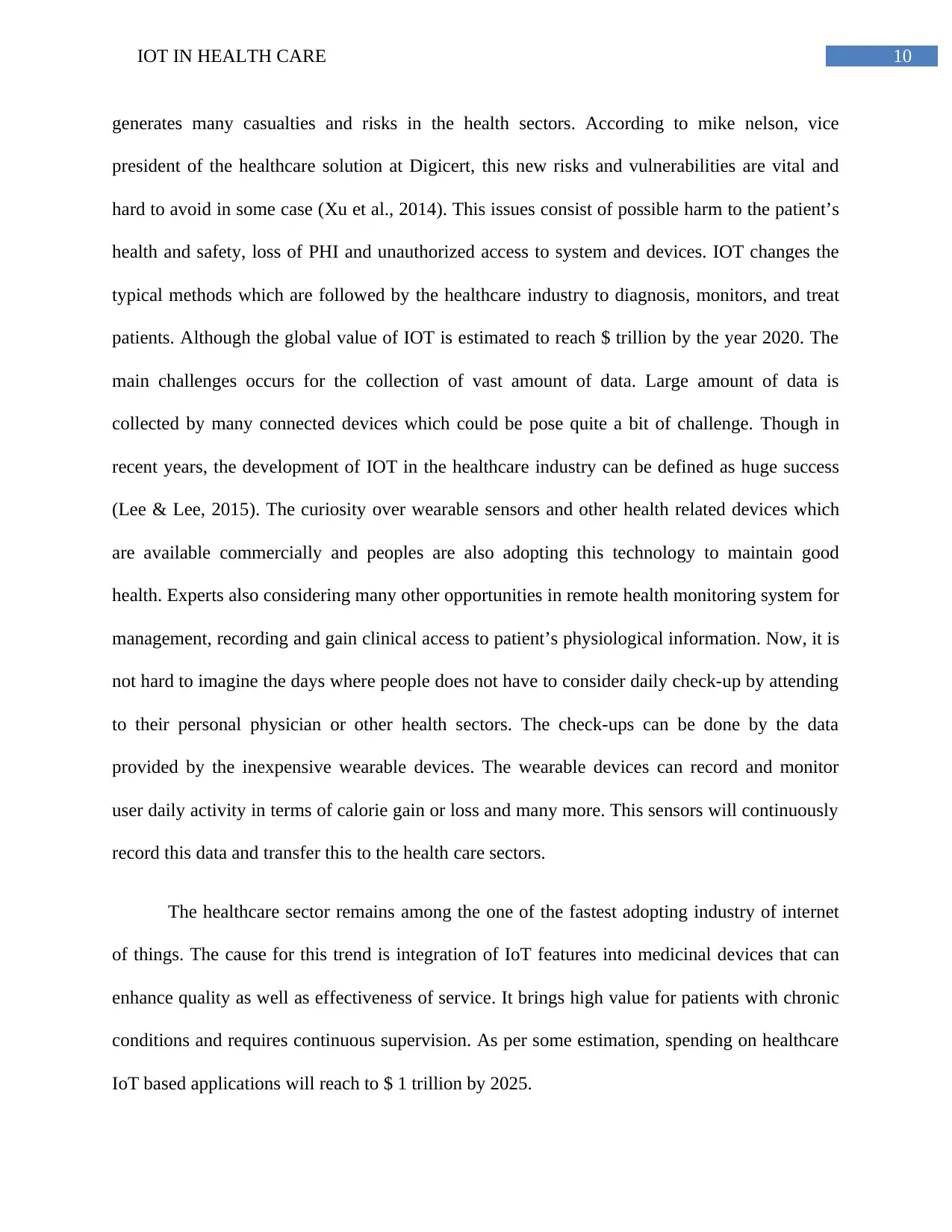
10IOT IN HEALTH CARE
generates many casualties and risks in the health sectors. According to mike nelson, vice
president of the healthcare solution at Digicert, this new risks and vulnerabilities are vital and
hard to avoid in some case (Xu et al., 2014). This issues consist of possible harm to the patient’s
health and safety, loss of PHI and unauthorized access to system and devices. IOT changes the
typical methods which are followed by the healthcare industry to diagnosis, monitors, and treat
patients. Although the global value of IOT is estimated to reach $ trillion by the year 2020. The
main challenges occurs for the collection of vast amount of data. Large amount of data is
collected by many connected devices which could be pose quite a bit of challenge. Though in
recent years, the development of IOT in the healthcare industry can be defined as huge success
(Lee & Lee, 2015). The curiosity over wearable sensors and other health related devices which
are available commercially and peoples are also adopting this technology to maintain good
health. Experts also considering many other opportunities in remote health monitoring system for
management, recording and gain clinical access to patient’s physiological information. Now, it is
not hard to imagine the days where people does not have to consider daily check-up by attending
to their personal physician or other health sectors. The check-ups can be done by the data
provided by the inexpensive wearable devices. The wearable devices can record and monitor
user daily activity in terms of calorie gain or loss and many more. This sensors will continuously
record this data and transfer this to the health care sectors.
The healthcare sector remains among the one of the fastest adopting industry of internet
of things. The cause for this trend is integration of IoT features into medicinal devices that can
enhance quality as well as effectiveness of service. It brings high value for patients with chronic
conditions and requires continuous supervision. As per some estimation, spending on healthcare
IoT based applications will reach to $ 1 trillion by 2025.
generates many casualties and risks in the health sectors. According to mike nelson, vice
president of the healthcare solution at Digicert, this new risks and vulnerabilities are vital and
hard to avoid in some case (Xu et al., 2014). This issues consist of possible harm to the patient’s
health and safety, loss of PHI and unauthorized access to system and devices. IOT changes the
typical methods which are followed by the healthcare industry to diagnosis, monitors, and treat
patients. Although the global value of IOT is estimated to reach $ trillion by the year 2020. The
main challenges occurs for the collection of vast amount of data. Large amount of data is
collected by many connected devices which could be pose quite a bit of challenge. Though in
recent years, the development of IOT in the healthcare industry can be defined as huge success
(Lee & Lee, 2015). The curiosity over wearable sensors and other health related devices which
are available commercially and peoples are also adopting this technology to maintain good
health. Experts also considering many other opportunities in remote health monitoring system for
management, recording and gain clinical access to patient’s physiological information. Now, it is
not hard to imagine the days where people does not have to consider daily check-up by attending
to their personal physician or other health sectors. The check-ups can be done by the data
provided by the inexpensive wearable devices. The wearable devices can record and monitor
user daily activity in terms of calorie gain or loss and many more. This sensors will continuously
record this data and transfer this to the health care sectors.
The healthcare sector remains among the one of the fastest adopting industry of internet
of things. The cause for this trend is integration of IoT features into medicinal devices that can
enhance quality as well as effectiveness of service. It brings high value for patients with chronic
conditions and requires continuous supervision. As per some estimation, spending on healthcare
IoT based applications will reach to $ 1 trillion by 2025.
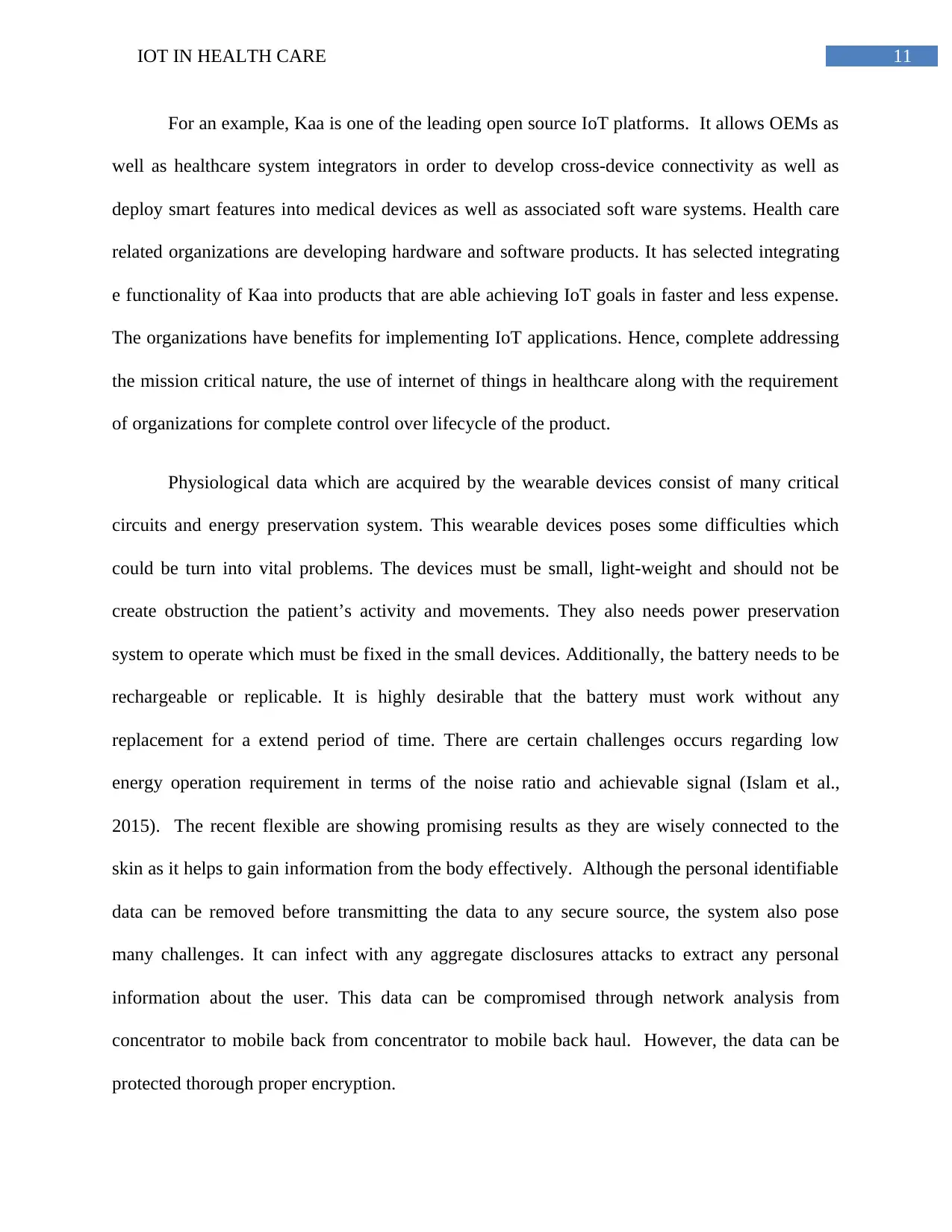
11IOT IN HEALTH CARE
For an example, Kaa is one of the leading open source IoT platforms. It allows OEMs as
well as healthcare system integrators in order to develop cross-device connectivity as well as
deploy smart features into medical devices as well as associated soft ware systems. Health care
related organizations are developing hardware and software products. It has selected integrating
e functionality of Kaa into products that are able achieving IoT goals in faster and less expense.
The organizations have benefits for implementing IoT applications. Hence, complete addressing
the mission critical nature, the use of internet of things in healthcare along with the requirement
of organizations for complete control over lifecycle of the product.
Physiological data which are acquired by the wearable devices consist of many critical
circuits and energy preservation system. This wearable devices poses some difficulties which
could be turn into vital problems. The devices must be small, light-weight and should not be
create obstruction the patient’s activity and movements. They also needs power preservation
system to operate which must be fixed in the small devices. Additionally, the battery needs to be
rechargeable or replicable. It is highly desirable that the battery must work without any
replacement for a extend period of time. There are certain challenges occurs regarding low
energy operation requirement in terms of the noise ratio and achievable signal (Islam et al.,
2015). The recent flexible are showing promising results as they are wisely connected to the
skin as it helps to gain information from the body effectively. Although the personal identifiable
data can be removed before transmitting the data to any secure source, the system also pose
many challenges. It can infect with any aggregate disclosures attacks to extract any personal
information about the user. This data can be compromised through network analysis from
concentrator to mobile back from concentrator to mobile back haul. However, the data can be
protected thorough proper encryption.
For an example, Kaa is one of the leading open source IoT platforms. It allows OEMs as
well as healthcare system integrators in order to develop cross-device connectivity as well as
deploy smart features into medical devices as well as associated soft ware systems. Health care
related organizations are developing hardware and software products. It has selected integrating
e functionality of Kaa into products that are able achieving IoT goals in faster and less expense.
The organizations have benefits for implementing IoT applications. Hence, complete addressing
the mission critical nature, the use of internet of things in healthcare along with the requirement
of organizations for complete control over lifecycle of the product.
Physiological data which are acquired by the wearable devices consist of many critical
circuits and energy preservation system. This wearable devices poses some difficulties which
could be turn into vital problems. The devices must be small, light-weight and should not be
create obstruction the patient’s activity and movements. They also needs power preservation
system to operate which must be fixed in the small devices. Additionally, the battery needs to be
rechargeable or replicable. It is highly desirable that the battery must work without any
replacement for a extend period of time. There are certain challenges occurs regarding low
energy operation requirement in terms of the noise ratio and achievable signal (Islam et al.,
2015). The recent flexible are showing promising results as they are wisely connected to the
skin as it helps to gain information from the body effectively. Although the personal identifiable
data can be removed before transmitting the data to any secure source, the system also pose
many challenges. It can infect with any aggregate disclosures attacks to extract any personal
information about the user. This data can be compromised through network analysis from
concentrator to mobile back from concentrator to mobile back haul. However, the data can be
protected thorough proper encryption.
⊘ This is a preview!⊘
Do you want full access?
Subscribe today to unlock all pages.

Trusted by 1+ million students worldwide
1 out of 23
Related Documents
Your All-in-One AI-Powered Toolkit for Academic Success.
+13062052269
info@desklib.com
Available 24*7 on WhatsApp / Email
![[object Object]](/_next/static/media/star-bottom.7253800d.svg)
Unlock your academic potential
Copyright © 2020–2025 A2Z Services. All Rights Reserved. Developed and managed by ZUCOL.





